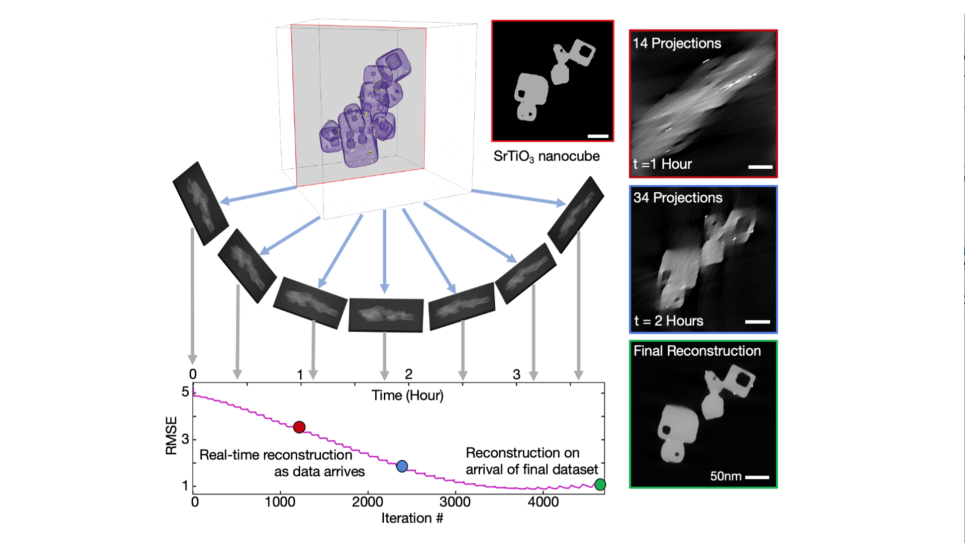
The flat and the curious
The remarkable properties of 2-D materials — made up of a single layer of atoms — have made them among the most intensely studied materials of our time. They have the potential to usher in a new generation of improved electronics, batteries and sensory devices, among other applications.
One obstacle to realizing applications of these materials is the cost and time needed for experimental studies. However, computer simulations are helping researchers overcome this challenge in order to accurately characterize material structures and functions at an accelerated pace.
At the U.S. Department of Energy’s (DOE) Argonne National Laboratory, researchers have simulated the growth of silicene, a 2-D material with attractive electronic properties. Their work, published in Nanoscale, delivers new and useful insights on the material’s properties and behavior and offers a predictive model for other researchers studying 2-D materials.
Going forward, this model can accelerate researchers’ understanding of 2-D materials, and bring us closer to realizing their applications within a wide range of industries.
In simulations, Argonne researchers observed silicene, made up of one layer of silicon atoms, evolve as it grew on the metal iridium. The scientists developed their model with support from Argonne’s Center for Nanoscale Materials and the Argonne Leadership Computing Facility (ALCF) – both DOE Office of Science User Facilities - and using experimental data on silicene growth.
“We used experimental data to build the model,” said Mathew Cherukara, Argonne postdoctoral researcher and lead author. “We then used this version of the model to make predictions under different conditions, and also learn the underlying physical processes that govern the growth of the material.”
The authors then worked with ALCF researchers to simulate the growth of silicene atom by atom. They simulated the material under varying conditions, altering variables such as temperature and the rate that silicene was deposited, until they found the best conditions to create a single, uniform layer.
“Essentially we did virtual ‘experiments’ to optimize different variables, all at a much lower cost than in the lab,” said Badri Narayanan, Argonne materials scientist and joint lead author. “Now, others can avoid much of the trial and error within the lab. Instead they can experiment using the optimized set of conditions our model predicts to best yield the structures and properties they desire.”
With silicene, silicon atoms can arrange themselves in four-, five- or even six-member rings, forming clusters or islands. Its material properties can drastically change depending on the number of atoms in a ring, the size and distribution of these rings and how they connect to each other over time.
“In the simulations, we resorted to using machine learning algorithms to identify these tiny clusters on the fly,” said Argonne Postdoctoral Fellow and co-author Henry Chan. “The size and shape of the clusters and how they combine ultimately dictate the properties of these 2-D materials.”
One advantage of modeling 2-D materials such as silicene is that researchers can visualize atomic interactions and configurations, like the formation of intermediate clusters during the growth process. These often evolve too fast for researchers to capture during experiments.
“It is very difficult to capture clusters or islands forming because they happen over very short timescales and tiny length scales,” said Subramanian Sankaranarayanan, Argonne scientist and co-author. “Our simulations, which capture just tens of nanoseconds, succeed in showing how these tiny structures form and reveal the optimal conditions to actually tune the structures one way or another.”
“Silicene growth through island migration and coalescence” was featured on the cover of the August issue of Nanoscale.
This work was funded by Argonne’s Laboratory Directed Research and Development program. Use of the Center for Nanoscale Materials and the Argonne Leadership Computing Facility was supported by the DOE Office of Science’s Office of Basic Energy Sciences. Computing time was awarded through the Innovative and Novel Computational Impact on Theory and Experiment (INCITE) program, supported by DOE’s Office of Science.
Argonne National Laboratory seeks solutions to pressing national problems in science and technology. The nation's first national laboratory, Argonne conducts leading-edge basic and applied scientific research in virtually every scientific discipline. Argonne researchers work closely with researchers from hundreds of companies, universities, and federal, state and municipal agencies to help them solve their specific problems, advance America's scientific leadership and prepare the nation for a better future. With employees from more than 60 nations, Argonne is managed by UChicago Argonne, LLC for the U.S. Department of Energy's Office of Science.
The U.S. Department of Energy's Office of Science is the single largest supporter of basic research in the physical sciences in the United States and is working to address some of the most pressing challenges of our time. For more information, visit the Office of Science website.


